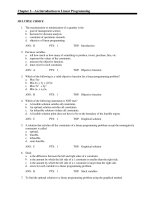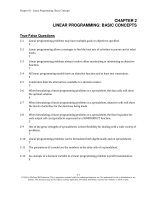Introduction to management science 10e by bernard taylor chapter 14
Bạn đang xem bản rút gọn của tài liệu. Xem và tải ngay bản đầy đủ của tài liệu tại đây (7.23 MB, 65 trang )
Simulation
Chapter 14
Copyright © 2010 Pearson Education, Inc. Publishing as
Prentice Hall
14-1
Chapter Topics
■The Monte Carlo Process
■Computer Simulation with Excel
Spreadsheets
■Simulation of a Queuing System
■Continuous Probability Distributions
■Statistical Analysis of Simulation Results
■Crystal Ball
■Verification of the Simulation Model
■Areas of Simulation Application
Copyright © 2010 Pearson Education, Inc. Publishing as
Prentice Hall
14-2
Overview
■ Analogue simulation replaces a physical system
with an analogous physical system that is easier to
manipulate.
■ In computer mathematical simulation a system
is replaced with a mathematical model that is
analyzed with the computer.
■ Simulation offers a means of analyzing very
complex systems that cannot be analyzed using
the other management science techniques in the
text.
Copyright © 2010 Pearson Education, Inc. Publishing as
Prentice Hall
14-3
Monte Carlo Process
■ A large proportion of the applications of simulations
are for probabilistic models.
■ The Monte Carlo technique is defined as a
technique for selecting numbers randomly from a
probability distribution for use in a trial (computer
run) of a simulation model.
■ The basic principle behind the process is the same
as in the operation of gambling devices in casinos
(such as those in Monte Carlo, Monaco).
Copyright © 2010 Pearson Education, Inc. Publishing as
Prentice Hall
14-4
Monte Carlo Process
Use of Random Numbers (1 of 10)
In the Monte Carlo process, values for a random
variable are generated by sampling from a
probability distribution.
Example: ComputerWorld demand data for laptops
selling for $4,300 over a period of 100 weeks.
Table 14.1 Probability Distribution of Demand
for Laptop PC’s
Copyright © 2010 Pearson Education, Inc. Publishing as
Prentice Hall
14-5
Monte Carlo Process
Use of Random Numbers (2 of 10)
The purpose of the Monte Carlo process is
to generate the random variable,
demand, by sampling from the probability
distribution P(x).
The partitioned roulette wheel replicates the
probability distribution for demand if the
values of demand occur in a random
manner.
The segment at which the wheel stops
Copyright © 2010 Pearson Education, Inc. Publishing as
Prentice Hall
14-6
Monte Carlo Process
Use of Random Numbers (3 of 10)
Figure 14.1 A Roulette Wheel
for Demand
Copyright © 2010 Pearson Education, Inc. Publishing as
Prentice Hall
14-7
Monte Carlo Process
Use of Random Numbers (4 of 10)
When the wheel is spun, the actual demand for PCs is
determined by a number at rim of the wheel.
Figure 14.2
umbered Roulette Wheel
Copyright © 2010 Pearson Education, Inc. Publishing as
Prentice Hall
14-8
Monte Carlo Process
Use of Random Numbers (5 of 10)
Table 14.2 Generating Demand from
Random Numbers
Copyright © 2010 Pearson Education, Inc. Publishing as
Prentice Hall
14-9
Monte Carlo Process
Use of Random Numbers (6 of 10)
Select number from a random number table:
Copyright © 2010 Pearson Education, Inc. Publishing as
Prentice Hall
Table 14.3
Numbers
Delightfully Random
14-
Monte Carlo Process
Use of Random Numbers (7 of 10)
Repeating selection of random numbers
simulates demand for a period of time.
Estimated average demand = 31/15 = 2.07
laptop PCs per week.
Estimated average revenue = $133,300/15
= $8,886.67.
Copyright © 2010 Pearson Education, Inc. Publishing as
Prentice Hall
14-
Monte Carlo Process
Use of Random Numbers (8 of 10)
Copyright © 2010 Pearson Education, Inc. Publishing as
Prentice Hall
Table 14.4
14-
Monte Carlo Process
Use of Random Numbers (9 of 10)
Average demand could have been calculated
analytically:
n
E( x) = ∑ P( xi) xi
i=1
where:
xi = demand value i
P( xi) = probability of demand
n = the number of different demand values
therefore:
E( x) = (.20)(0) + (.40)(1) + (.20)(2) + (.10)(3) + (.10)(4)
= 1.5 PC's per week
Copyright © 2010 Pearson Education, Inc. Publishing as
Prentice Hall
14-
Monte Carlo Process
Use of Random Numbers (10 of 10)
The more periods simulated, the more accurate
the results.
Simulation results will not equal analytical results
unless enough trials have been conducted to reach
steady state.
Often difficult to validate results of simulation that true steady state has been reached and that
simulation model truly replicates reality.
When analytical analysis is not possible, there is no
14analytical standard of comparison thus making
Copyright © 2010 Pearson Education, Inc. Publishing as
Prentice Hall
Computer Simulation with Excel
Spreadsheets
Generating Random Numbers (1 of
2) As simulation models get more complex they
become impossible to perform manually.
In simulation modeling, random numbers are
generated by a mathematical process instead
of a physical process (such as wheel spinning).
Random numbers are typically generated on the
computer using a numerical technique and thus are
not true random numbers but pseudorandom
numbers.
Copyright © 2010 Pearson Education, Inc. Publishing as
Prentice Hall
14-
Computer Simulation with Excel
Spreadsheets
Generating Random Numbers (2 of
2)
Artificially created random numbers must have
the following characteristics:
1.
The random numbers must be
uniformly distributed.
2.
The numerical technique for generating
the numbers must be efficient.
3.
The sequence of random numbers should
reflect no pattern.
Copyright © 2010 Pearson Education, Inc. Publishing as
Prentice Hall
14-
Simulation with Excel Spreadsheets
(1 of 3)
Copyright © 2010 Pearson Education, Inc. Publishing as
Prentice Hall
Exhibit 14.1
14-
Simulation with Excel Spreadsheets
(2 of 3)
Copyright © 2010 Pearson Education, Inc. Publishing as
Prentice Hall
Exhibit 14.2
14-
Simulation with Excel Spreadsheets
(3 of 3)
Copyright © 2010 Pearson Education, Inc. Publishing as
Prentice Hall
Exhibit 14.3
14-
Computer Simulation with Excel
Spreadsheets
Decision
Making example;
with Simulation
(1 laptop
Revised ComputerWorld
order size of one
each
of
2)week.
Exhibit 14.4
Copyright © 2010 Pearson Education, Inc. Publishing as
Prentice Hall
14-
Computer Simulation with Excel
Spreadsheets
Decision
with Simulation
Order sizeMaking
of two laptops
each week. (2
of 2)
Exhibit 14.5
Copyright © 2010 Pearson Education, Inc. Publishing as
Prentice Hall
14-
Simulation of a Queuing System
Burlingham Mills Example (1 of 3)
Table 14.5 Distribution of
Arrival Intervals
Table 14.6 Distribution of
Copyright © 2010 Pearson Education, Inc. Publishing as
Prentice Hall
14-
Simulation of a Queuing System
Burlingham Mills Example (2 of 3)
Average waiting time = 12.5days/10 batches
= 1.25 days per batch
Average time in the system = 24.5 days/10
batches
Copyright
© 2010 Pearson Education, Inc. Publishing as
Prentice Hall
= 2.45 days per batch
14-
Simulation of a Queuing System
Burlingham Mills Example (3 of 3)
Caveats:
■
Results may be viewed with skepticism.
■
Ten trials do not ensure steady-state
results.
■
Starting conditions can affect
simulation results.
■
If no batches are in the system at start,
simulation must run until it replicates
normal operating system.
If system starts with items already in the
Copyright © 2010 Pearson Education, Inc. Publishing as
simulation must begin with
Prentice Hall system,
14■
Computer Simulation with Excel
Burlingham Mills Example
Exhibit 14.6
Copyright © 2010 Pearson Education, Inc. Publishing as
Prentice Hall
14-









